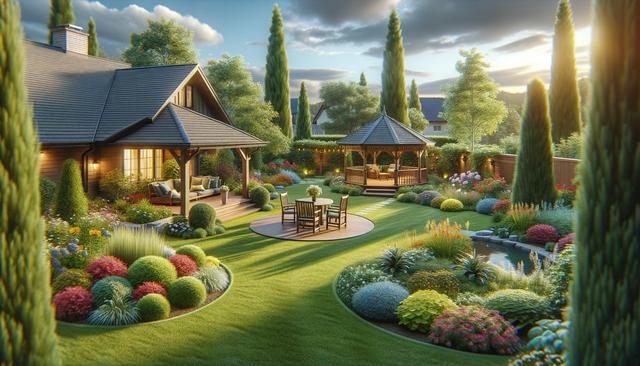Backyard Landscaping Ideas to Refresh Your Outdoor Space
Transform your yard with simple ideas like neat grass, bold trees, small ponds, and bright blooms. Add fun paths, comfy seats, and cool lights to make your space a place to chill and enjoy nature.

Designing with Greenery and Lawn Structure
One of the most effective ways to shape your backyard is by starting with the lawn. A well-maintained lawn sets the stage for the rest of the space. Whether you prefer a traditional grass lawn or a low-maintenance alternative like clover or native ground cover, keeping it neat makes a big difference. Consider curved edges around the lawn to give it a softer, more organic look. Adding shrubs and ornamental grasses around the perimeter can also create a seamless transition to flower beds or other features. Use mulch or stone borders to keep everything in place and reduce maintenance over time.
To incorporate variety, mix different types of plants that thrive in your climate. This could include:
- Evergreen hedges for year-round structure
- Perennials that return each season
- Annuals for vibrant seasonal color
- Fruit trees or berry bushes for edible landscaping
By layering plants of different heights and textures, you’ll give your backyard dimension and visual interest. This approach is both practical and visually appealing, especially when arranged around a central lawn or patio.
Creating Cozy Seating Areas
Outdoor seating is essential for turning your backyard into a space where people want to spend time. Whether you have a small patio or a spacious yard, there are plenty of ways to add comfortable seating. Patio furniture sets, built-in benches, or even repurposed materials like wooden pallets can be used to create a welcoming environment. Think about the layout—position seating to take advantage of natural shade, or add a pergola or umbrella for sun protection.
Here are a few seating ideas to consider:
- Stone or brick sitting walls
- Portable lounge chairs with colorful cushions
- Hammocks or hanging swings for a relaxed vibe
- Fire pit areas with circular seating
Don’t forget to include small tables or side surfaces for drinks, books, or plants. By combining comfort with functionality, your seating area becomes a natural gathering point for family and friends.
Incorporating Water Features
Water has a calming effect and adds a unique sensory element to any backyard. From simple birdbaths to more elaborate ponds or fountains, there are many ways to introduce water features without major construction. A small pond, for example, can become a focal point with koi fish, aquatic plants, and surrounding stones. If space is limited, a wall-mounted fountain or container water garden can deliver a similar effect on a smaller scale.
Benefits of adding water features include:
- Attracting birds and beneficial insects
- Masking neighborhood noise with soothing sounds
- Enhancing the overall aesthetic with reflection and movement
When planning a water feature, ensure it is placed where it can be easily enjoyed—near a seating area, outside a window, or along a main path. Incorporate lighting to highlight the feature at night, creating ambiance that extends into the evening hours.
Pathways and Garden Walks
Paths can tie a backyard together by guiding visitors through different areas and adding structure to open spaces. Whether you choose gravel, stone pavers, or wood chips, pathways contribute to both function and design. They make it easier to navigate the space and protect your lawn and plants from foot traffic. Curved paths are especially effective for creating a sense of flow and can connect key areas such as patios, garden beds, and sheds.
Some practical and visual enhancements include:
- Stepping stones through garden beds
- Gravel or brick walkways between garden zones
- Arbors or trellises placed along paths for vertical interest
- Solar lights to illuminate paths at night
Using materials that contrast with the surrounding lawn or mulch can make your paths stand out. You can also line them with low-growing plants or ground cover to soften the edges and make them more inviting.
Adding Lighting and Decorative Touches
Lighting plays a crucial role in how your backyard feels after sunset. Soft, warm lights create a welcoming atmosphere, while well-placed task lighting ensures safety. Solar-powered stake lights, string lights, and lanterns are popular choices that require little installation effort. Use them to highlight pathways, accent trees, or frame seating areas.
In addition to lighting, small decorative elements can personalize your space. Consider adding:
- Garden sculptures or wind chimes
- Planters with seasonal flowers
- Outdoor rugs to define seating areas
- Vertical gardens or trellis walls for climbing plants
These small additions help bring personality and charm to your backyard, making it feel like an extension of your indoor living space. The key is to balance utility with style, ensuring that each element serves a purpose while enhancing the overall design.
Conclusion: Bringing It All Together
With thoughtful planning and a few creative touches, transforming your backyard into a relaxing and functional space is entirely achievable. Whether you focus on greenery, seating, water features, or lighting, each element adds depth and comfort to your outdoor area. Start small, build over time, and tailor your landscaping to your lifestyle and local environment. With consistent care and a bit of imagination, your backyard can become a peaceful retreat that invites you to unwind and enjoy nature every day.